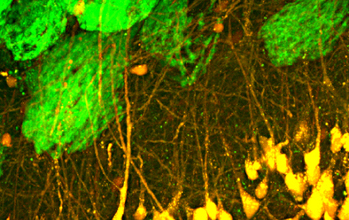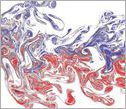News Release 15-113
NSF awards $15 million to crack the olfactory code
Research will advance a broader understanding of the brain

Olfactory sensory neurons (green) transfer information to olfactory projection neurons (yellow).
September 21, 2015
This material is available primarily for archival purposes. Telephone numbers or other contact information may be out of date; please see current contact information at media contacts.
Since the early 19th century, scientists have worked to unravel the mystery of olfaction, the sense of smell.
Olfaction is critical for the survival of species across the animal kingdom. Yet how the brain processes and identifies odors--and how this information influences behavior--remains, largely, an enigma.
To help solve this mystery, and advance our broader understanding of the brain, the National Science Foundation (NSF) has awarded more than $15 million for three projects to research the intricacies of olfaction. These awards support 17 researchers who combined innovative ideas from multiple disciplines into collaborative projects, all designed to transform scientists' understanding of neural coding of odors.
"Olfaction is both an important and tractable problem in neuroscience," said James Olds, assistant director of the Biological Sciences Directorate. "By using the olfactory system, which is an ancient system, as a model for neural circuits, we can gain insights into the fundamental principles underlying neural activity and complex behaviors."
The awards expand NSF's investments in the President's BRAIN Initiative. They are funded by NSF's Directorates for Biological Sciences and Mathematical and Physical Sciences (MPS).
"The inclusion of physical and mathematical methods to this research will prove invaluable," said Krastan B. Blagoev, program director for Physics of Living Systems in MPS. "Blending biology with physics and mathematics adds an important new dimension to studying biological processes, by allowing us to explore biological mechanisms at the most basic, molecular level in a quantitative and predictive way."
The research proposals arose from the NSF Olfactory Ideas Lab workshop, held in June at the Janelia Farm Research Campus. The labs are intense meetings that bring together scientists and engineers from disparate fields to formulate innovative ideas and develop potentially transformative research proposals. This Ideas Lab involved 30 researchers; over the course of five days, they forged teams and hashed out five project ideas. These three awards were selected from the final proposals submitted by those teams.
Olfactory navigation: Dynamic computing in the natural environment: Animals--from flies to humans--use olfaction to find resources, such as food and mates. How do such different creatures, with such different brains, all share this ability? This team will work to uncover the algorithmic and mechanistic processes governing this deeply embedded behavior. They will quantify odor plumes--and how odors distribute in natural environments--and measure how animals behave in olfactory environments. The principal investigators are: John Crimaldi, University of Colorado; Lucia Jacobs, University of California, Berkeley; Jonathan Victor, Weill Cornell Medical College; Nathaniel Urban, University of Pittsburgh; G. Bard Ermentrout, University of Pittsburgh; Katherine Nagel, New York University Medical Center; Justus Verhagen, John Pierce Laboratory.
Using natural odor stimuli to crack the olfactory code: This project will use fruit flies and honeybees as model organisms to probe the olfactory circuit. Instead of using synthetic odor stimuli to study olfaction--the common practice now--the team will create natural ones, by collecting, analyzing and modeling naturally occurring odor samples from each insect's environment. Studying olfactory circuits with natural stimuli could reveal new neurological features and behaviors. The principal investigators are: Brian Smith, Arizona State University; Aravinthan Samuel, Harvard University; Elizabeth Hong, California Institute of Technology; Tatyana Sharpee, Salk Institute for Biological Studies.
Analysis of the mammalian olfactory code: The mammalian olfactory sense is truly amazing. It can swiftly discriminate between thousands of odors, and parse out the different smells in complex odor combinations. This project will investigate the process of odor recognition, focusing on how basic features of odor perception--odor identity and valence, which is the behavioral significance attached to an odor--are encoded in the brain. The principal investigators are: Hiroaki Matsunami, Duke University; Sriram Kosuri, University of California, Los Angeles; Dale Wachowiak, University of Utah; Marcelo Magnasco, Rockefeller University; Vladimir Itskov, Pennsylvania State University; Lisa Stowers, Scripps Research Institute.
-NSF-
-
One project will use honeybees to study how the olfactory circuit works.
Credit and Larger Version -
A laser-based experimental visualization of two interacting odor plumes.
Credit and Larger Version
Media Contacts
Jessica Arriens, NSF, (703) 292-2243, email: jarriens@nsf.gov
The U.S. National Science Foundation propels the nation forward by advancing fundamental research in all fields of science and engineering. NSF supports research and people by providing facilities, instruments and funding to support their ingenuity and sustain the U.S. as a global leader in research and innovation. With a fiscal year 2023 budget of $9.5 billion, NSF funds reach all 50 states through grants to nearly 2,000 colleges, universities and institutions. Each year, NSF receives more than 40,000 competitive proposals and makes about 11,000 new awards. Those awards include support for cooperative research with industry, Arctic and Antarctic research and operations, and U.S. participation in international scientific efforts.
Connect with us online
NSF website: nsf.gov
NSF News: nsf.gov/news
For News Media: nsf.gov/news/newsroom
Statistics: nsf.gov/statistics/
Awards database: nsf.gov/awardsearch/
Follow us on social
Twitter: twitter.com/NSF
Facebook: facebook.com/US.NSF
Instagram: instagram.com/nsfgov


